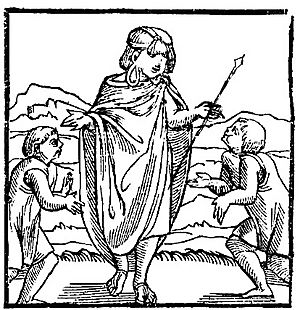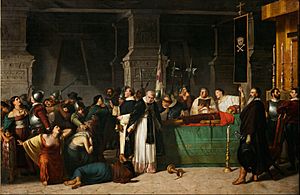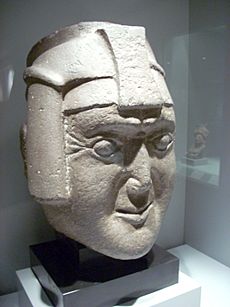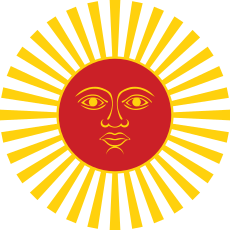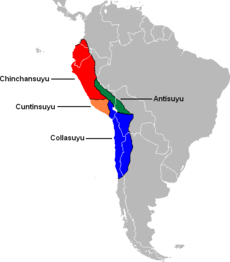Inca Empire facts for kids
Quick facts for kids
Realm of the Four Parts
Tawantinsuyu (Quechua)
|
|||||||||||||||||||
|---|---|---|---|---|---|---|---|---|---|---|---|---|---|---|---|---|---|---|---|
| 1438–1533/1572 | |||||||||||||||||||
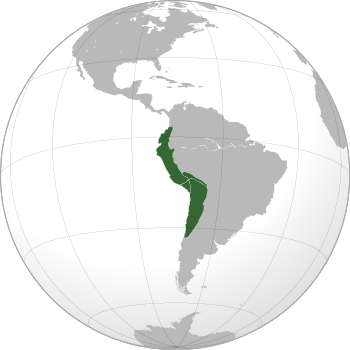
The Inca Empire at its greatest extent c. 1525
|
|||||||||||||||||||
| Capital | Cusco | ||||||||||||||||||
| Official languages | Quechua | ||||||||||||||||||
| Common languages | Aymara, Puquina, Jaqi family, Muchik and scores of smaller languages. | ||||||||||||||||||
| Religion | Inca religion | ||||||||||||||||||
| Government | Divine, absolute monarchy | ||||||||||||||||||
| Sapa Inca | |||||||||||||||||||
|
• 1438–1471
|
Pachacuti | ||||||||||||||||||
|
• 1471–1493
|
Túpac Inca Yupanqui | ||||||||||||||||||
|
• 1493–1527
|
Huayna Capac | ||||||||||||||||||
| Historical era | Pre-Columbian era | ||||||||||||||||||
|
• Pachacuti created the Tawantinsuyu
|
1438 | ||||||||||||||||||
| 1529–1532 | |||||||||||||||||||
|
• Spanish conquest led by Francisco Pizarro
|
1533/1572 | ||||||||||||||||||
|
• End of the last Inca resistance
|
1572 | ||||||||||||||||||
| Area | |||||||||||||||||||
| 1527 | 2,000,000 km2 (770,000 sq mi) | ||||||||||||||||||
|
|||||||||||||||||||
The Inca Empire (also known as the Incan Empire and the Inka Empire) was the largest empire in pre-Columbian America. The city of Cusco was its center.
The Inca civilization arose from the Peruvian highlands sometime in the early 13th century. The Spanish began the conquest of the Inca Empire in 1532 and by 1572, the last Inca state was fully conquered.
From 1438 to 1533, the Incas incorporated a large portion of western South America. At its largest, the empire joined modern-day Peru, what are now western Ecuador, western and south central Bolivia, northwest Argentina, the southwesternmost tip of Colombia and a large portion of modern-day Chile into a state comparable to the historical empires of Eurasia. Its official language was Quechua.
The Inca Empire was unique in that it lacked many of the features associated with civilization in the Old World. Anthropologist Gordon McEwan wrote that the Incas were able to construct "one of the greatest imperial states in human history" without the use of the wheel, draft animals, knowledge of iron or steel, or even a system of writing. Notable features of the Inca Empire included its monumental architecture, especially stonework, extensive road network reaching all corners of the empire, finely-woven textiles, use of knotted strings (quipu) for record keeping and communication, agricultural innovations and production in a difficult environment, and the organization and management fostered or imposed on its people and their labor.
The Inca Empire functioned largely without money and without markets. Instead, exchange of goods and services was based on reciprocity between individuals and among individuals, groups, and Inca rulers. "Taxes" consisted of a labour obligation of a person to the Empire. The Inca rulers (who theoretically owned all the means of production) reciprocated by granting access to land and goods and providing food and drink in celebratory feasts for their subjects.
Many local forms of worship persisted in the empire, most of them concerning local sacred Huacas, but the Inca leadership encouraged the sun worship of Inti – their sun god – and imposed its sovereignty above other cults such as that of Pachamama. The Incas considered their king, the Sapa Inca, to be the "son of the sun".
The Incan economy is a subject of scholarly debate. Darrell E. La Lone, in his work The Inca as a Nonmarket Economy, noted that scholars have described it as "feudal, slave, [or] socialist," as well as "a system based on reciprocity and redistribution; a system with markets and commerce; or an Asiatic mode of production."
Contents
Etymology
The Inca referred to their empire as Tawantinsuyu, "the four suyu". In Quechua, tawa is four and -ntin is a suffix naming a group, so that a tawantin is a quartet, a group of four things taken together, in this case the four suyu ("regions" or "provinces") whose corners met at the capital. The four suyu were: Chinchaysuyu (north), Antisuyu (east; the Amazon jungle), Qullasuyu (south) and Kuntisuyu (west). The name Tawantinsuyu was, therefore, a descriptive term indicating a union of provinces. The Spanish transliterated the name as Tahuatinsuyo or Tahuatinsuyu.
While the term Inka nowaydays is translated as "ruler" or "lord" in Quechua, this term does not simply refer to the "King" of the Tawantinsuyu or Sapa Inka but also to the Inca nobles, and some theorize its meaning could be broader. In that sense, the Inca nobles were a small percentage of the total population of the empire, probably numbering only 15,000 to 40,000, but ruling a population of around 10 million people.
When the Spanish arrived to the Empire of the Incas they gave the name "Peru" to what the natives knew as Tawantinsuyu. The name "Inca Empire" (Imperio de los Incas) originated from the Chronicles of the 16th Century.
History
- Further information: History of Cusco
Antecedents
The Inca Empire was the last chapter of thousands of years of Andean civilizations. The Andean civilization is one of at least five civilizations in the world deemed by scholars to be "pristine", that is indigenous and not derivative from other civilizations.
The Inca Empire was preceded by two large-scale empires in the Andes: the Tiwanaku (c. 300–1100 AD), based around Lake Titicaca, and the Wari or Huari (c. 600–1100 AD), centered near the city of Ayacucho. The Wari occupied the Cuzco area for about 400 years. Thus, many of the characteristics of the Inca Empire derived from earlier multi-ethnic and expansive Andean cultures. To those earlier civilizations may be owed some of the accomplishments cited for the Inca Empire: "thousands of miles of roads and dozens of large administrative centers with elaborate stone construction...terraced mountainsides and filled in valleys", and the production of "vast quantities of goods".
Carl Troll has argued that the development of the Inca state in the central Andes was aided by conditions that allow for the elaboration of the staple food chuño. Chuño, which can be stored for long periods, is made of potato dried at the freezing temperatures that are common at nighttime in the southern Peruvian highlands. Such a link between the Inca state and chuño may be questioned, as other crops such as maize can also be dried with only sunlight.
Troll also argued that llamas, the Incas' pack animal, can be found in their largest numbers in this very same region. The maximum extent of the Inca Empire roughly coincided with the distribution of llamas and alpacas, the only large domesticated animals in Pre-Hispanic America.
As a third point Troll pointed out irrigation technology as advantageous to Inca state-building. While Troll theorized concerning environmental influences on the Inca Empire, he opposed environmental determinism, arguing that culture lay at the core of the Inca civilization.
Origin

The Inca people were a pastoral tribe in the Cusco area around the 12th century. Indigenous Peruvian oral history tells an origin story of three caves. The center cave at Tampu T'uqu (Tambo Tocco) was named Qhapaq T'uqu ("principal niche", also spelled Capac Tocco). The other caves were Maras T'uqu (Maras Tocco) and Sutiq T'uqu (Sutic Tocco). Four brothers and four sisters stepped out of the middle cave. They were: Ayar Manco, Ayar Cachi, Ayar Awqa (Ayar Auca) and Ayar Uchu; and Mama Ocllo, Mama Raua, Mama Huaco and Mama Qura (Mama Cora). Out of the side caves came the people who were to be the ancestors of all the Inca clans.

Ayar Manco carried a magic staff made of the finest gold. Where this staff landed, the people would live. They traveled for a long time. On the way, Ayar Cachi boasted about his strength and power. His siblings tricked him into returning to the cave to get a sacred llama. When he went into the cave, they trapped him inside to get rid of him.
Ayar Uchu decided to stay on the top of the cave to look over the Inca people. The minute he proclaimed that, he turned to stone. They built a shrine around the stone and it became a sacred object. Ayar Auca grew tired of all this and decided to travel alone. Only Ayar Manco and his four sisters remained.
Finally, they reached Cusco. The staff sank into the ground. Before they arrived, Mama Ocllo had already borne Ayar Manco a child, Sinchi Roca. The people who were already living in Cusco fought hard to keep their land, but Mama Huaca was a good fighter. When the enemy attacked, she threw her bolas (several stones tied together that spun through the air when thrown) at a soldier (gualla) and killed him instantly. The other people became afraid and ran away.
After that, Ayar Manco became known as Manco Cápac, the founder of the Inca. It is said that he and his sisters built the first Inca homes in the valley with their own hands. When the time came, Manco Cápac turned to stone like his brothers before him. His son, Sinchi Roca, became the second emperor of the Inca.
Kingdom of Cusco
Under the leadership of Manco Cápac, the Inca formed the small city-state Kingdom of Cusco (Quechua Qusqu', Qosqo). In 1438, they began a far-reaching expansion under the command of Sapa Inca (paramount leader) Pachacuti-Cusi Yupanqui, whose name meant "earth-shaker". The name of Pachacuti was given to him after he conquered the Tribe of Chancas (modern Apurímac). During his reign, he and his son Tupac Yupanqui brought much of the modern-day territory of Peru under Inca control.
Reorganization and formation
Pachacuti reorganized the kingdom of Cusco into the Tahuantinsuyu, which consisted of a central government with the Inca at its head and four provincial governments with strong leaders: Chinchasuyu (NW), Antisuyu (NE), Kuntisuyu (SW) and Qullasuyu (SE). Pachacuti is thought to have built Machu Picchu, either as a family home or summer retreat, although it may have been an agricultural station.
Pachacuti sent spies to regions he wanted in his empire and they brought to him reports on political organization, military strength and wealth. He then sent messages to their leaders extolling the benefits of joining his empire, offering them presents of luxury goods such as high quality textiles and promising that they would be materially richer as his subjects.
Most accepted the rule of the Inca as a fait accompli and acquiesced peacefully. Refusal to accept Inca rule resulted in military conquest. Following conquest the local rulers were executed. The ruler's children were brought to Cusco to learn about Inca administration systems, then return to rule their native lands. This allowed the Inca to indoctrinate them into the Inca nobility and, with luck, marry their daughters into families at various corners of the empire.
Expansion and consolidation
Traditionally the son of the Inca ruler led the army. Pachacuti's son Túpac Inca Yupanqui began conquests to the north in 1463 and continued them as Inca ruler after Pachacuti's death in 1471. Túpac Inca's most important conquest was the Kingdom of Chimor, the Inca's only serious rival for the Peruvian coast. Túpac Inca's empire then stretched north into what are today Ecuador and Colombia.
Túpac Inca's son Huayna Cápac added a small portion of land to the north in what is today Ecuador. At its height, the Inca Empire included modern-day Peru, what are today western and south central Bolivia, southwest Ecuador and Colombia and a large portion of modern-day Chile, at the north of the Maule River. Traditional historiography claims the advance south halted after the Battle of the Maule where they met determined resistance from the Mapuche.
This view is challenged by historian Osvaldo Silva who argues instead that it was the social and political framework of the Mapuche that posed the main difficulty in imposing imperial rule. Silva does accept that the battle of the Maule was a stalemate, but argues the Incas lacked incentives for conquest they had had when fighting more complex societies such as the Chimú Empire.
Silva also disputes the date given by traditional historiography for the battle: the late 15th century during the reign of Topa Inca Yupanqui (1471–93). Instead, he places it in 1532 during the Inca Civil War. Nevertheless, Silva agrees on the claim that the bulk of the Incan conquests were made during the late 15th century. At the time of the Incan Civil War an Inca army was, according to Diego de Rosales, subduing a revolt among the Diaguitas of Copiapó and Coquimbo.
The empire's push into the Amazon Basin near the Chinchipe River was stopped by the Shuar in 1527. The empire extended into corners of what are today the north of Argentina and part of the southern Colombia. However, most of the southern portion of the Inca empire, the portion denominated as Qullasuyu, was located in the Altiplano.
The Inca Empire was an amalgamation of languages, cultures and peoples. The components of the empire were not all uniformly loyal, nor were the local cultures all fully integrated. The Inca empire as a whole had an economy based on exchange and taxation of luxury goods and labour. The following quote describes a method of taxation:
For as is well known to all, not a single village of the highlands or the plains failed to pay the tribute levied on it by those who were in charge of these matters. There were even provinces where, when the natives alleged that they were unable to pay their tribute, the Inca ordered that each inhabitant should be obliged to turn in every four months a large quill full of live lice, which was the Inca's way of teaching and accustoming them to pay tribute.
Inca Civil War and Spanish conquest
Spanish conquistadors led by Francisco Pizarro and his brothers explored south from what is today Panama, reaching Inca territory by 1526. It was clear that they had reached a wealthy land with prospects of great treasure, and after another expedition in 1529 Pizarro traveled to Spain and received royal approval to conquer the region and be its viceroy. This approval was received as detailed in the following quote: "In July 1529 the Queen of Spain signed a charter allowing Pizarro to conquer the Incas. Pizarro was named governor and captain of all conquests in Peru, or New Castile, as the Spanish now called the land".
When the conquistadors returned to Peru in 1532, a war of succession between the sons of Sapa Inca Huayna Capac, Huáscar and Atahualpa, and unrest among newly conquered territories weakened the empire. Perhaps more importantly, smallpox, influenza, typhus and measles had spread from Central America. The first epidemic of European disease in the Inca Empire was probably in the 1520s, killing Huayna Capac, his designated heir, and an unknown, probably large, number of other Incan subjects.
The forces led by Pizarro consisted of 168 men, one cannon, and 27 horses. Conquistadors ported lances, arquebuses, steel armor and long swords. In contrast, the Inca used weapons made out of wood, stone, copper and bronze, while using an Alpaca fiber based armor, putting them at significant technological disadvantage—none of their weapons could pierce the Spanish steel armor. In addition, due to the absence of horses in Peru, the Inca did not develop tactics to fight cavalry. However, the Inca were still effective warriors, being able to successfully fight the Mapuche, which later would strategically defeat the Spanish as they expanded further south.
The first engagement between the Inca and the Spanish was the Battle of Puná, near present-day Guayaquil, Ecuador, on the Pacific Coast; Pizarro then founded the city of Piura in July 1532. Hernando de Soto was sent inland to explore the interior and returned with an invitation to meet the Inca, Atahualpa, who had defeated his brother in the civil war and was resting at Cajamarca with his army of 80,000 troops, that were at the moment armed only with hunting tools (knives and lassos for hunting llamas).
Pizarro and some of his men, most notably a friar named Vincente de Valverde, met with the Inca, who had brought only a small retinue. The Inca offered them ceremonial chicha in a golden cup, which the Spanish rejected. The Spanish interpreter, Friar Vincente, read the "Requerimiento" that demanded that he and his empire accept the rule of King Charles I of Spain and convert to Christianity. Atahualpa dismissed the message and asked them to leave. After this, the Spanish began their attack against the mostly unarmed Inca, captured Atahualpa as hostage, and forced the Inca to collaborate.
Atahualpa offered the Spaniards enough gold to fill the room he was imprisoned in and twice that amount of silver. The Inca fulfilled this ransom, but Pizarro deceived them, refusing to release the Inca afterwards. During Atahualpa's imprisonment Huáscar was assassinated elsewhere. The Spaniards maintained that this was at Atahualpa's orders; this was used as one of the charges against Atahualpa when the Spaniards finally executed him, in August 1533.
Although "defeat" often implies an unwanted loss in battle, many of the diverse ethnic groups ruled by the Inca "welcomed the Spanish invaders as liberators and willingly settled down with them to share rule of Andean farmers and miners". Many regional leaders, called Kurakas, continued to serve the Spanish overlords, called encomenderos, as they had served the Inca overlords. Other than efforts to spread the religion of Christianity, the Spanish benefited from and made little effort to change the society and culture of the former Inca Empire until the rule of Francisco de Toledo as viceroy from 1569 to 1581.
End of the Inca Empire
The Spanish installed Atahualpa's brother Manco Inca Yupanqui in power; for some time Manco cooperated with the Spanish while they fought to put down resistance in the north. Meanwhile, an associate of Pizarro, Diego de Almagro, attempted to claim Cusco. Manco tried to use this intra-Spanish feud to his advantage, recapturing Cusco in 1536, but the Spanish retook the city afterwards. Manco Inca then retreated to the mountains of Vilcabamba and established the small Neo-Inca State, where he and his successors ruled for another 36 years, sometimes raiding the Spanish or inciting revolts against them. In 1572 the last Inca stronghold was conquered and the last ruler, Túpac Amaru, Manco's son, was captured and executed. This ended resistance to the Spanish conquest under the political authority of the Inca state.
After the fall of the Inca Empire many aspects of Inca culture were destroyed, including their farming system. Spanish colonial officials used the Inca mita corvée labor system for colonial aims, sometimes brutally. One member of each family was forced to work in the gold and silver mines, the foremost of which was the titanic silver mine at Potosí. When a family member died, which would usually happen within a year or two, the family was required to send a replacement.
Beginning in Colombia, smallpox spread rapidly before the Spanish invaders first arrived in the empire. The spread was probably aided by the efficient Inca road system. Smallpox was only the first epidemic. Other diseases, including a probable typhus outbreak in 1546, influenza and smallpox together in 1558, smallpox again in 1589, diphtheria in 1614, and measles in 1618, all ravaged the Inca people.
Society
Population
The number of people inhabiting Tawantinsuyu at its peak is uncertain, with estimates ranging from 4–37 million. Most population estimates are in the range of 6 to 14 million. In spite of the fact that the Inca kept excellent census records using their quipus, knowledge of how to read them was lost as almost all fell into disuse and disintegrated over time or were destroyed by the Spaniards.
Languages
The empire was extremely linguistically diverse. Some of the most important languages were Quechua, Aymara, Puquina and Mochica, respectively mainly spoken in the Central Andes, the Altiplano or (Qullasuyu), the south Peruvian coast (Kuntisuyu), and the area of the north Peruvian coast (Chinchaysuyu) around Chan Chan, today Trujillo. Other languages included Quignam, Jaqaru, Leco, Uru-Chipaya languages, Kunza, Humahuaca, Cacán, Mapudungun, Culle, Chachapoya, Catacao languages, Manta, and Barbacoan languages, as well as numerous Amazonian languages on the frontier regions.
In order to manage this diversity, the Inca lords promoted the usage of Quechua, especially the variety of what is now Lima as the Qhapaq Runasimi ("great language of the people"), or the official language/lingua franca. Quechua is actually a family of languages rather than one single language. Most communities within the empire, even those resistant to Inca rule, learned to speak a variety of Quechua in order to communicate with the Inca lords and mitma colonists, but largely retained their native languages as well. The Incas also had their own ethnic language, referred to as Qhapaq simi ("royal language"), which is thought to have been closely related to or a dialect of Puquina. The split between Qhapaq simi and Qhapaq Runasimi exemplifies the larger split between hatun and hunin (high and low) society in general.
Quechua did not originate with the Incas, had been a lingua franca in multiple areas before the Inca expansions, was diverse before the rise of the Incas, and it was not the native or original language of the Incas. However, the Incas left an impressive linguistic legacy, in that they introduced Quechua to many areas where it is still widely spoken today, including Ecuador, southern Bolivia, southern Colombia, and parts of the Amazon basin. The Spanish conquerors continued the official usage of Quechua during the early colonial period, and transformed it into a literary language.
The Incas were not known to develop a written form of language; however, they visually recorded narratives through paintings on vases and cups (qirus). These paintings are usually accompanied by geometric patterns known as toqapu, which are also found in textiles. Researchers have speculated that toqapu patterns could have served as a form of written communication (e.g.: heraldry, or glyphs), however this remains unclear. The Incas also kept records by using quipus.
Age and defining gender
All newborn infants were given the term 'wawa' when they were born. Once the child reached the age of three, a "coming of age" ceremony occurred, called the rutuchikuy. For the Incas, this ceremony indicated that the child had entered the stage of "ignorance". During this ceremony, the family would invite all relatives to their house for food and dance, and then each member of the family would receive a lock of hair from the child. After each family member had received a lock, the father would shave the child's head. This stage of life was categorized by a stage of "ignorance, inexperience, and lack of reason, a condition that the child would overcome with time".
The next important ritual was to celebrate the maturity of a child. This celebration was called warachikuy for boys and qikuchikuy for girls. The warachikuy ceremony included dancing, fasting, tasks to display strength, and family ceremonies. The boy would also be given new clothes and taught how to act as an unmarried man. The qikuchikuy signified the girl had reached puberty. She was then given a new name, adult clothing, and advice.
Between the ages of 20 and 30, people were considered young adults, "ripe for serious thought and labor". Young adults were able to retain their youthful status by living at home and assisting in their home community. Young adults only reached full maturity and independence once they had married.
| Table 7.1 from R. Alan Covey's Article | |||
| Age | Social Value of Life Stage | Female Term | Male Term |
| < 3 | Conception | Wawa | Wawa |
| 3–7 | Ignorance (not speaking) | Warma | Warma |
| 7–14 | Development | Thaski (or P'asña) | Maqt'a |
| 14–20 | Folly (sexually active) | Sipas (unmarried) | Wayna (unmarried) |
| 20+ | Maturity (body and mind) | Warmi | Qhari |
| 70 | Infirmity | Paya | Machu |
| 90 | Decrepitude | Ruku | Ruku |
Marriage
In the Incan Empire, the age of marriage differed for men and women: men typically married at the age of 20, while women usually got married about four years earlier at the age of 16. Men who were highly ranked in society could have multiple wives, but those lower in the ranks could only take a single wife. Marriages were typically within classes. Once married, the women were expected to cook, collect food and watch over the children and livestock. Girls and mothers would also work around the house to keep it orderly to please the public inspectors. These duties remained the same even after wives became pregnant and with the added responsibility of praying and making offerings to Kanopa, who was the god of pregnancy.
If the man felt that the marriage wouldn't work out or if the woman wanted to return to her parents' home, the couple could divorce. The divorce was possible only if the spouses did not have children together.
Gender roles
According to some historians, such as Terence N. D'Altroy, male and female roles were considered equal in Inca society. Women's everyday tasks included: spinning, watching the children, weaving cloth, cooking, brewing chichi, preparing fields for cultivation, planting seeds, bearing children, harvesting, weeding, hoeing, herding, and carrying water. Men on the other hand, "weeded, plowed, participated in combat, helped in the harvest, carried firewood, built houses, herded llama and alpaca, and spun and wove when necessary". This relationship between the genders may have been complementary. Unsurprisingly, onlooking Spaniards believed women were treated like slaves, because women did not work in Spanish society to the same extent, and certainly did not work in fields. Women were sometimes allowed to own land and herds because inheritance was passed down from both the mother's and father's side of the family.
Burial customs
It is believed that the ancient Incas learned to mummify their dead to show reverence to their leaders and representatives. Mummification was chosen to preserve the body and to give others the opportunity to worship them in their death. The ancient Inca believed in reincarnation, so preservation of the body was vital for passage into the afterlife. Mummification was reserved for royalty. The ancient Inca mummified their dead with various tools. Chicha corn beer was used to delay decomposition and the effects of bacterial activity on the body. The bodies were then stuffed with natural materials such as vegetable matter and animal hair. Sticks were to used to maintain their shape and poses. In addition to the mummification process, the Inca would bury their dead in the fetal position inside a vessel, preparing them for their new birth. A ceremony would be held that included music, food, and drink for the relatives and loved ones of the deceased.
Religion
Inca myths were transmitted orally until early Spanish colonists recorded them; however, some scholars claim that they were recorded on quipus, Andean knotted string records.
The Inca believed in reincarnation. After death, the passage to the next world was fraught with difficulties. The spirit of the dead, camaquen, would need to follow a long road and during the trip the assistance of a black dog that could see in the dark was required. Most Incas imagined the after world to be like an earthly paradise with flower-covered fields and snow-capped mountains.
It was important to the Inca that they not die as a result of burning or that the body of the deceased not be incinerated. Burning would cause their vital force to disappear and threaten their passage to the after world. The Inca nobility practiced cranial deformation. They wrapped tight cloth straps around the heads of newborns to shape their soft skulls into a more conical form, thus distinguishing the nobility from other social classes.
The Incas made human sacrifices. As many as 4,000 servants, court officials, favorites and concubines were killed upon the death of the Inca Huayna Capac in 1527.
Deities
The Incas were polytheists who worshipped many gods. These included:
- Viracocha (also Pachacamac) – Created all living things
- Apu Illapu – Rain God, prayed to when they need rain
- Ayar Cachi – Hot-tempered God, causes earthquakes
- Illapa – Goddess of lightning and thunder (also Yakumama water goddess)
- Inti – sun god and patron deity of the holy city of Cusco (home of the sun)
- Kuychi – Rainbow God, connected with fertility
- Mama Killa – Wife of Inti, called Moon Mother
- Mama Occlo – Wisdom to civilize the people, taught women to weave cloth and build houses
- Manco Cápac – known for his courage and sent to earth to become first king of the Incas. Taught people how to grow plants, make weapons, work together, share resources and worship the Gods
- Pachamama – The Goddess of earth and wife of Viracocha. People give her offerings of coca leaves and beer and pray to her for major agricultural occasions
- Quchamama – Goddess of the sea
- Sachamama – Means Mother Tree, goddess in the shape of a snake with two heads
- Yakumama – Means mother Water. Represented as a snake. When she came to earth she transformed into a great river (also Illapa).
Economy
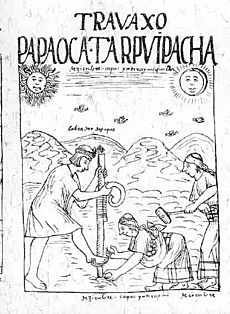
The Inca Empire traded with outside regions. Most households in the empire were required to pay taxes, usually in the form of the mit'a corvée labor, and military obligations, though barter (or trueque) was present in some areas. In return, the state provided security, food in times of hardship through the supply of emergency resources, agricultural projects (e.g. aqueducts and terraces) to increase productivity, and occasional feasts hosted by Inca officials for their subjects. While mit'a was used by the state to obtain labor, individual villages had a pre-inca system of communal work, known as mink'a. This system survives to the modern day, known as mink'a or faena.
Government
Beliefs
The Sapa Inca was conceptualized as divine and was effectively head of the state religion. The Willaq Umu (or Chief Priest) was second to the emperor. Local religious traditions continued and in some cases such as the Oracle at Pachacamac on the Peruvian coast, were officially venerated. Following Pachacuti, the Sapa Inca claimed descent from Inti, who placed a high value on imperial blood. He was "son of the sun", and his people the intip churin, or "children of the sun", and both his right to rule and mission to conquer derived from his holy ancestor. The Sapa Inca also presided over ideologically important festivals, notably during the Inti Raymi, or "Sunfest" attended by soldiers, mummified rulers, nobles, clerics and the general population of Cusco beginning on the June solstice and culminating nine days later with the ritual breaking of the earth using a foot plow by the Inca. Moreover, Cusco was considered cosmologically central, loaded as it was with huacas and radiating ceque lines as the geographic center of the Four-Quarters; Inca Garcilaso de la Vega called it "the navel of the universe".
Organization of the empire
The Inca Empire was a federalist system consisting of a central government with the Inca at its head and four regional quarters, or suyu: Chinchay Suyu (NW), Anti Suyu (NE), Kunti Suyu (SW) and Qulla Suyu (SE). The four corners of these quarters met at the center, Cusco. These suyu were likely created around 1460 during the reign of Pachacuti before the empire reached its largest territorial extent. At the time the suyu were established they were roughly of equal size and only later changed their proportions as the empire expanded north and south along the Andes.
Cusco was likely not organized as a wamani, or province. Rather, it was probably somewhat akin to a modern federal district, like Washington, DC or Mexico City. The city sat at the center of the four suyu and served as the preeminent center of politics and religion. While Cusco was essentially governed by the Sapa Inca, his relatives and the royal panaqa lineages, each suyu was governed by an Apu, a term of esteem used for men of high status and for venerated mountains. Both Cusco as a district and the four suyu as administrative regions were grouped into upper hanan and lower hurin divisions. As the Inca did not have written records, it is impossible to exhaustively list the constituent wamani. However, colonial records allow us to reconstruct a partial list. There were likely more than 86 wamani, with more than 48 in the highlands and more than 38 on the coast.
Suyu
The most populous suyu was Chinchaysuyu, which encompassed the former Chimu empire and much of the northern Andes. At its largest extent, it extended through much of what are now Ecuador and Colombia.
The largest suyu by area was Qullasuyu, named after the Aymara-speaking Qulla people. It encompassed what is now the Bolivian Altiplano and much of the southern Andes, reaching what is now Argentina and as far south as the Maipo or Maule river in modern Central Chile. Historian José Bengoa singled out Quillota as likely being the foremost Inca settlement in Chile.
The second smallest suyu, Antisuyu, was northwest of Cusco in the high Andes. Its name is the root of the word "Andes".
Kuntisuyu was the smallest suyu, located along the southern coast of modern Peru, extending into the highlands towards Cusco.
Laws
The Inca had no codified laws. Customs and traditions governed behavior. The state had legal force, such as through tokoyrikoq (lit. "he who sees all"), or inspectors. The highest such inspector, was typically a blood relative to the Sapa Inca.
The Inca had three moral precepts that governed their behavior:
- Ama sua: Do not steal
- Ama llulla: Do not lie
- Ama quella: Do not be lazy
Administration
The Sapa Inca was at the top of the Inca government structure. He was aided by the Willaq Umu, literally the "priest who recounts", the High Priest of the Sun. The Sapa Inca also had the Inkap rantin, an assistant, perhaps similar to a Prime Minister.
Starting with Topa Inca Yupanqui, the Sapa Inca was assisted by a Council of the Realm. It was made up of 16 nobles, the governors of the empire's provinces.
Males of a certain age were organized into units that formed part of mit'a service. Each unit of more than 100 males were headed by a kuraka, while smaller units were headed by a kamayuq, a lower, non-hereditary status.
| Kuraka in Charge | Number of Taxpayers |
|---|---|
| Hunu kuraka | 10,000 |
| Pichkawaranqa kuraka | 5,000 |
| Waranqa kuraka | 1,000 |
| Pichkapachaka kuraka | 500 |
| Pachaka kuraka | 100 |
| Pichkachunka kamayuq | 50 |
| Chunka kamayuq | 10 |
Arts and technology
Monumental architecture
We can assure your majesty that it is so beautiful and has such fine buildings that it would even be remarkable in Spain.
Architecture was the most important of the Incan arts. The most notable example is Machu Picchu, which was constructed by Inca engineers. The prime Inca structures were made of stone blocks that fit together so well that a knife could not be fitted through the stonework. These constructs have survived for centuries, with no use of mortar to sustain them.
This process was first used on a large scale by the Pucara (c. 300 BC–AD 300) peoples to the south in Lake Titicaca and later in the city of Tiwanaku (c. AD 400–1100) in what is now Bolivia. The rocks were sculpted to fit together exactly by repeatedly lowering a rock onto another and carving away any sections on the lower rock where the dust was compressed. The tight fit and the concavity on the lower rocks made them extraordinarily stable, despite the ongoing challenge of earthquakes and volcanic activity.
Measures, calendrics and mathematics
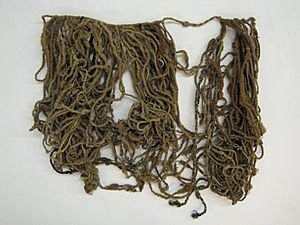
Physical measures used by the Inca were based on human body parts. Units included fingers, the distance from thumb to forefinger, palms, cubits and wingspans. The most basic distance unit was thatkiy or thatki, or one pace. The next largest unit was reported by Cobo to be the topo or tupu, measuring 6,000 thatkiys, or about 7.7 km (4.8 mi); careful study has shown that a range of 4.0 to 6.3 km (2.5 to 3.9 mi) is likely. Next was the wamani, composed of 30 topos (roughly 232 km or 144 mi). To measure area, 25 by 50 wingspans were used, reckoned in topos (roughly 3,280 km2 or 1,270 sq mi). It seems likely that distance was often interpreted as one day's walk.
Inca calendars were strongly tied to astronomy. Inca astronomers understood equinoxes, solstices and zenith passages, along with the Venus cycle. They could not, however, predict eclipses. The Inca had a solar and a lunar calendar. Each lunar month was marked with festivals and rituals. Apparently, the days of the week were not named and days were not grouped into weeks. Similarly, months were not grouped into seasons. Time during a day was not measured in hours or minutes, but in terms of how far the sun had travelled or in how long it had taken to perform a task.
Numerical information was stored in the knots of quipu strings, allowing for compact storage of large numbers. These numbers were stored in base-10 digits, the same base used by the Quechua language and in administrative and military units. These numbers, stored in quipu, could be calculated on yupanas, grids with squares of positionally varying mathematical values, perhaps functioning as an abacus. Calculation was facilitated by moving piles of tokens, seeds or pebbles between compartments of the yupana. It is likely that Inca mathematics at least allowed division of integers into integers or fractions and multiplication of integers and fractions.
Tunics
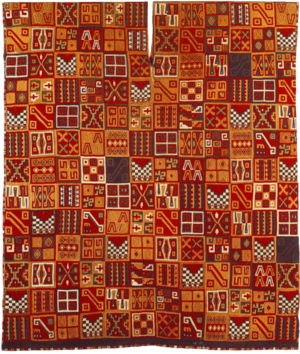
Tunics were created by skilled Incan textile-makers as a piece of warm clothing. They also symbolized cultural and political status and power. Cumbi was the fine, tapestry-woven woolen cloth that was produced and necessary for the creation of tunics. Cumbi was produced by specially-appointed women and men. Generally, textile-making was practiced by both men and women.
Complex patterns and designs conveyed information about order in Andean society as well as the Universe. Tunics could also symbolize one's relationship to ancient rulers or important ancestors. Many tunics have a "checkerboard effect" which is known as the collcapata. Rulers wore various tunics throughout the year, switching them out for different occasions and feasts.
Uncu
Uncu was a men's garment similar to a tunic. It was an upper-body garment of knee-length; Royals wore it with a mantle cloth called ''yacolla.''
Ceramics, precious metals and textiles
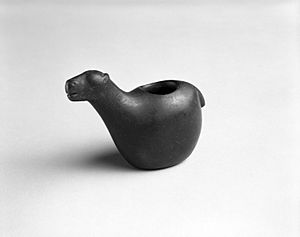
Ceramics were painted using the polychrome technique portraying numerous motifs including animals, birds, waves, felines (popular in the Chavin culture) and geometric patterns found in the Nazca style of ceramics. In a culture without a written language, ceramics portrayed the basic scenes of everyday life, including the smelting of metals, relationships and scenes of tribal warfare. The most distinctive Inca ceramic objects are the Cusco bottles or "aryballos". Many of these pieces are on display in Lima in the Larco Archaeological Museum and the National Museum of Archaeology, Anthropology and History.
Almost all of the gold and silver work of the Incan empire was melted down by the conquistadors, and shipped back to Spain.
Communication and medicine
The Inca recorded information on assemblages of knotted strings, known as Quipu, although they can no longer be decoded. Quipus are also believed to record history and literature.
The Inca made many discoveries in medicine. They performed successful skull surgery, by cutting holes in the skull to alleviate fluid buildup and inflammation caused by head wounds. Many skull surgeries performed by Inca surgeons were successful. Survival rates were 80–90%, compared to about 30% before Inca times.
Coca
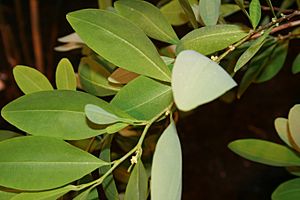
The Incas revered the coca plant as sacred/magical. Its leaves were used in moderate amounts to lessen hunger and pain during work, but were mostly used for religious and health purposes. The Chasqui, messengers who ran throughout the empire to deliver messages, chewed coca leaves for extra energy. Coca leaves were also used as an anaesthetic during surgeries.
Weapons, armor and warfare
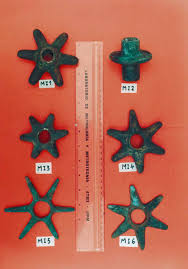
The Inca army was the most powerful at that time, because any ordinary villager or farmer could be recruited as a soldier as part of the mit'a system of mandatory public service. Every able bodied male Inca of fighting age had to take part in war in some capacity at least once and to prepare for warfare again when needed. By the time the empire reached its largest size, every section of the empire contributed in setting up an army for war.
The Incas had no iron or steel and their weapons were not much more effective than those of their opponents so they often defeated opponents by sheer force of numbers, or else by persuading them to surrender beforehand by offering generous terms. Inca weaponry included "hardwood spears launched using throwers, arrows, javelins, slings, the bolas, clubs, and maces with star-shaped heads made of copper or bronze". Rolling rocks downhill onto the enemy was a common strategy, taking advantage of the hilly terrain. Fighting was sometimes accompanied by drums and trumpets made of wood, shell or bone. Armor included:
- Helmets made of wood, cane, or animal skin, often lined with copper or bronze; some were adorned with feathers
- Round or square shields made from wood or hide
- Cloth tunics padded with cotton and small wooden planks to protect the spine
- Ceremonial metal breastplates, of copper, silver, and gold, have been found in burial sites, some of which may have also been used in battle.
Roads allowed quick movement (on foot) for the Inca army and shelters called tambo and storage silos called qullqas were built one day's travelling distance from each other, so that an army on campaign could always be fed and rested. This can be seen in names of ruins such as Ollantay Tambo, or My Lord's Storehouse. These were set up so the Inca and his entourage would always have supplies (and possibly shelter) ready as they traveled.
Adaptations to altitude
The people of the Andes, including the Incas, adapted to living in high altitudes. They developed a larger lung capacity, having about 2 L (4 pints) more blood volume. They also had more hemoglobin, a protein which transfers oxygen from the lungs to the rest of the body.
Compared to other humans, the Andeans had slower heart rates.
See also
 In Spanish: Imperio incaico para niños
In Spanish: Imperio incaico para niños
Incan archeological sites
- History of Cusco
- Atahualpa, last Inca Emperor
- Aclla, the "chosen women"
- Amauta, Inca teachers
- Amazonas before the Inca Empire
- Anden, agricultural terrace
- Inca army
- Inca cuisine
- Incan aqueducts
- Felipe Guaman Poma de Ayala
- Paria, Bolivia
- Religion in the Inca Empire
- Tampukancha, Inca religious site
- Society of the Spanish-Americans in the Spanish Colonial Americas




